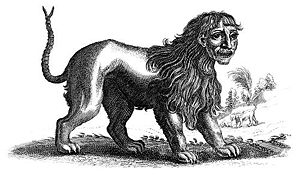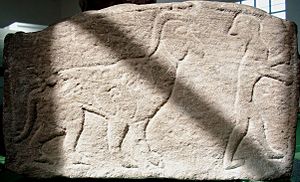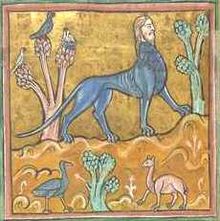- Manticore
-
The manticore (Early Middle Persian Martyaxwar; Βάρἰκος Baricos in Greek) is a legendary creature similar to the Egyptian sphinx. It has the body of a red lion, a human head with three rows of sharp teeth (like a shark), and a trumpet-like voice. Other aspects of the creature vary from story to story. It may be horned, winged, or both. The tail is that of either a dragon or a scorpion, and it may shoot poisonous spines to either paralyze or kill its victims. It devours its prey whole. It leaves no clothes, bones, or possessions of the prey behind. During the early centuries, it was a common belief that if a person went missing their disappearance was caused by a manticore and that manticore were real. The creature's feet may be those of a dragon, but are most often described as the paws of a lion. Its size ranges from the size of a lion to the size of a horse. It is also mistaken as a bearded man when seen from a distance.
Contents
Origin
The manticore myth was of Persian origin, where its name was "man-eater" (from early Middle Persian مارتیا martya "man" (as in human) and خوار xwar- "to eat"). The English term "manticore" was borrowed from Latin mantichora, itself borrowed from Greek μαντιχωρας—an erroneous pronunciation of the original Persian name. It passed into European folklore first through a remark by Ctesias, a Greek physician at the Persian court of King Artaxerxes II in the fourth century BC, in his notes on India ("Indika"), which circulated among Greek writers on natural history but have not survived. The Romanised Greek Pausanias, in his Description of Greece, recalled strange animals he had seen at Rome and commented,
The beast described by Ctesias in his Indian history, which he says is called martichoras by the Indians and "man-eater" by the Greeks, I am inclined to think is the tiger. But that it has three rows of teeth along each jaw and spikes at the tip of its tail with which it defends itself at close quarters, while it hurls them like an archer's arrows at more distant enemies; all this is, I think, a false story that the Indians pass on from one to another owing to their excessive dread of the beast. (Description, xxi, 5)
Pliny the Elder did not share Pausanias' skepticism. He followed Aristotle's natural history by including the martichoras—mistranscribed as manticorus in his copy of Aristotle and thus passing into European languages—among his descriptions of animals in Naturalis Historia, c. 77 AD.
Later, in The Life of Apollonius of Tyana Greek writer Flavius Philostratus (c. 170–247) wrote:
And inasmuch as the following conversation also has been recorded by Damis as having been held upon this occasion with regard to the mythological animals and fountains and men met with in India, I must not leave it out, for there is much to be gained by neither believing nor yet disbelieving everything. Accordingly Apollonius asked the question, whether there was there an animal called the man-eater (martichoras); and Iarchas replied: "And what have you heard about the make of this animal ? For it is probable that there is some account given of its shape." "There are," replied Apollonius, "tall stories current which I cannot believe; for they say that the creature has four feet, and that his head resembles that of a man, but that in size it is comparable to a lion; while the tail of this animal puts out hairs a cubit long and sharp as thorns, which it shoots like arrows at those who hunt it."[1]
Pliny's book was widely enjoyed and uncritically believed through the European Middle Ages, during which the manticore was sometimes illustrated in bestiaries. The manticore made a late appearance in heraldry, during the 16th century, and it influenced some Mannerist representations, as in Bronzino's allegory The Exposure of Luxury, (National Gallery, London)[2]— but more often in the decorative schemes called "grotteschi"— of the sin of Fraud, conceived as a monstrous chimera with a beautiful woman's face, and in this way it passed by means of Cesare Ripa's Iconologia into the seventeenth and eighteenth century French conception of a sphinx.
A manticore features as medieval sixteenth century graffiti on the wall of North Cerney church in Gloucestershire; it was seen as an unholy hybrid of the zodiacal signs Leo, Scorpio and Aquarius[3]
In popular culture
- In the Divine Comedy, Geryon is depicted as a manticore-like demon that dwells at the deep barrier between the circles of violence and fraud.
- Canadian writer Robertson Davies wrote a novel titled The Manticore, published in 1972. It is the second volume of his "Deptford Trilogy. [4]
- Following the success of their second album, Tarkus – which featured a manticore in the artwork and lyrics – Emerson, Lake & Palmer founded Manticore Records in 1973. An ELP retrospective box set released in 1993 was titled The Return of the Manticore, and included artwork similar to the manticore from Tarkus and the Manticore Records label.
- There is a manticore in My Little Pony: Friendship is Magic.
- In the BBC production, Merlin, episode 9 of series 3 (http://www.imdb.com/title/tt1762846/) entitled "Love in the Time of Dragons" features a manticore that controls Gaius' old love, the healer Alice.
- The Manticore is encountered as creatures of evil in the popular Castlevania series.
References
- Notes
- ^ Flavius Philostratus, The Life of Apollonius of Tyana, translated by F. C. Conybeare, volume I, book III. Chapter XLV, pp. 327-329.
- ^ John F. Moffitt, "An Exemplary Humanist Hybrid: Vasari's "Fraude" with Reference to Bronzino's 'Sphinx'" Renaissance Quarterly 49.2 (Summer 1996), pp. 303-333, traces the chimeric image of Fraud backwards from Bronzino.
- ^ Walker, Charles (1992). Mysterious Britain (2nd ed.). London: Grange Books. pp. 114. ISBN 1-85627-281-8.
- ^ Surawicz B, Jacobson B (2009). Doctors in Fiction: Lessons from Literature. Radcliffe Publishing. p. 125. ISBN 1846193281.
External links
Heraldic creatures Beasts 
Birds Legendary
creaturesBasilisk · Biscione · Chollima · Cockatrice · Dragon · Enfield · Garuda · Griffin/Keythong · Harpy · Lindworm · Manticore · Phoenix · Salamander · Turul · Unicorn · WyvernFish Others Categories:- European legendary creatures
- Heraldic beasts
- Mythological felines
- Mythological hybrids
- Persian legendary creatures
Wikimedia Foundation. 2010.




